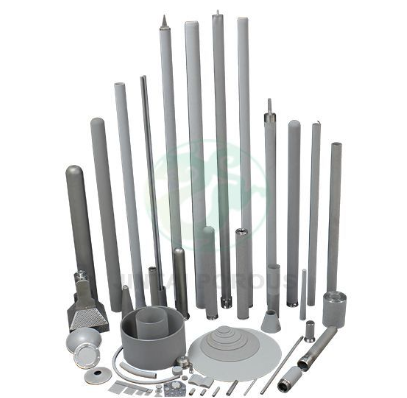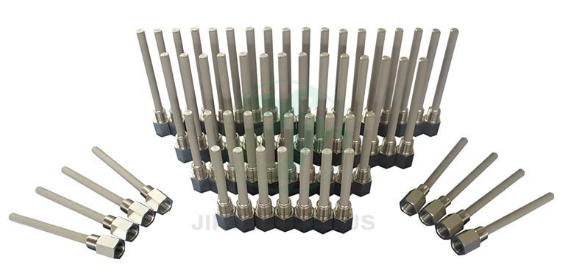Sintering vs Melting: What's the Difference?
- 5 sep, 2022
- 4239 visitas

Sintered Porous Metal Filter Element
For those who aren't familiar with manufacturing, and metal forming, in particular, the difference between melting and sintering may seem largely semantic. However, it is important to know that there are definite differences between a process that melts an object and a process that uses sintering.
What is Sintering?
Sintering is the process of fusing particles together into one solid mass by using a combination of pressure and heat without melting the materials. Common particles that are sintered together include metal, ceramic, plastic, and other various materials.
The Sintering Process in Metallurgy
The majority of metals can be sintered. Powder sintering is used to increase the strength and structural integrity of metal powders.The sintering process in metallurgy follows the fusing of metal powders, along with other materials such as alloying elements, using heat treatment in a (typically) single, elongated furnace with different temperature zones. The sintering temperature is always below the melting point of the materials to avoid melting.
The sintering process in metallurgy has three stages.
1. Initial Stage:
The first stage of metal powder sintering involves the materials being heated in the furnace at a temperature rate that induces the creation of martensitic, crystalline structures. Complete compaction does not occur because the sintering temperature is not high enough to melt the particles. Consolidating the materials can be accomplished through various means, including using tools to press the materials together or 3D printing lasers which can partially melt powders.
The particles can also be joined by cold welds to give the powder compact enough strength for the rest of the sintering process.
2. Intermediate Process:
The particle's density increases and they eventually merge. Two common ways to achieve this are transient liquid phase sintering and permanent liquid phase sintering.
If the sintering powder compact involves iron, then the transient liquid phase sintering is used. In this process, copper powder is added to the iron powder. At the regular sintering temperature, copper melts and infuses with the iron, hardening the materials together.
In the permanent liquid phase method, liquid materials such as cemented carbides are added and flow into the open pores and cracks, further binding the materials together.
3. Final Stage:
By this powder sintering stage, the original sintering powder materials have now become a mostly solid form. In the final stage of permanent liquid phase sintering, more liquid and binder additive flows into any open cracks or pores, successfully binding together the packed mass.
What Are the Differences Between Sintering and Melting?
Though both are methods used to combine materials, sintering and melting are significantly different.
Sintering Temperature and Liquefaction
One of the biggest differences is the liquefaction of the material.
A material that is melting is being brought to a temperature sufficient to turn it from a solid into a liquid—the material is being imbued with enough thermal energy to make the transition between energy states. A material that is being sintered is instead being compacted using a combination of heat and pressure without actually crossing the energy threshold required for turning into a liquid.
Why is this an important difference? It's important because sintering can occur at low temperatures in the right conditions. Take, for example, snow. Snow, when compacted into a ball by a child, would be an example of pressure-based sintering.
Basically, sintering can be an operation of either pressure or temperature, while melting is primarily an operation of temperature.

Sintered Porous Metal Filter Element
Uses of Sintering and Melting
While sintering and melting have similarities, they are in fact two different processes that have different applications.
ㆍUses of Sintering
Sintering has a few different uses. One of the key uses of sintering is to join metal particles together—sintering is often used on metals with high melting points, since it doesn't rely on reaching melting temperatures to work.
Some 3D printing devices operate by sintering metals one layer at a time to create custom metal forms. Sintering a metal for 3D printing could help to save energy compared to melting the same metal, and allows for greater control and consistency, since the material isn't being completely liquefied. However, this leaves more microscopic gaps than the full liquefaction caused by melting would.
Sintering can also be used to reduce the porosity of an object's surface—which can enhance the properties of certain materials.
ㆍUses of Melting
Melting, on the other hand, has many uses depending on the material being melted and why it's being melted. The process of liquefying metal is commonly used when joining two metals—similar to sintering. In fact, some processes that describe themselves as “sintering” (such as Direct Metal Laser Sintering) are actually melting materials—which can be a contributing factor to the confusion surrounding the two processes.
Another use of melting is to completely liquefy a metal alloy to reform it into a new shape or to change some of its physical characteristics.
For example, heating up magnetized steel can cause the steel to lose its magnetism by disrupting the alignment of the metal's atomic structure. However, for most magnetized metals, the magnet doesn't have to be fully melted to remove its magnetic properties—it merely has to reach its “Curie temperature,” which is the point at which the magnetized atoms lose their alignment.
In most manufacturing applications, melting is more commonly used to fuse two objects or to reform a metal than it is to change object properties.
Sintering and Melting Key Takeaways
Key points to remember about sintering and melting include:
ㆍSintering combines materials by heat and pressure, without melting involved.
ㆍMelting combines particles by heating them till they liquify and combine as one material.
ㆍSintering can occur at low temperatures if enough pressure is applied.
ㆍSintering is most often used in combining metals with high melting points and for creating custom metal forms with a 3D printer since the sintering temperature is so low.
ㆍMelting is commonly used for combining metals and for changing the physical characteristics of materials
Interested in sintered porous metal filter? Learn more about our products and contact us today!
- Categoría:
- Negocio
- Sin comentarios



